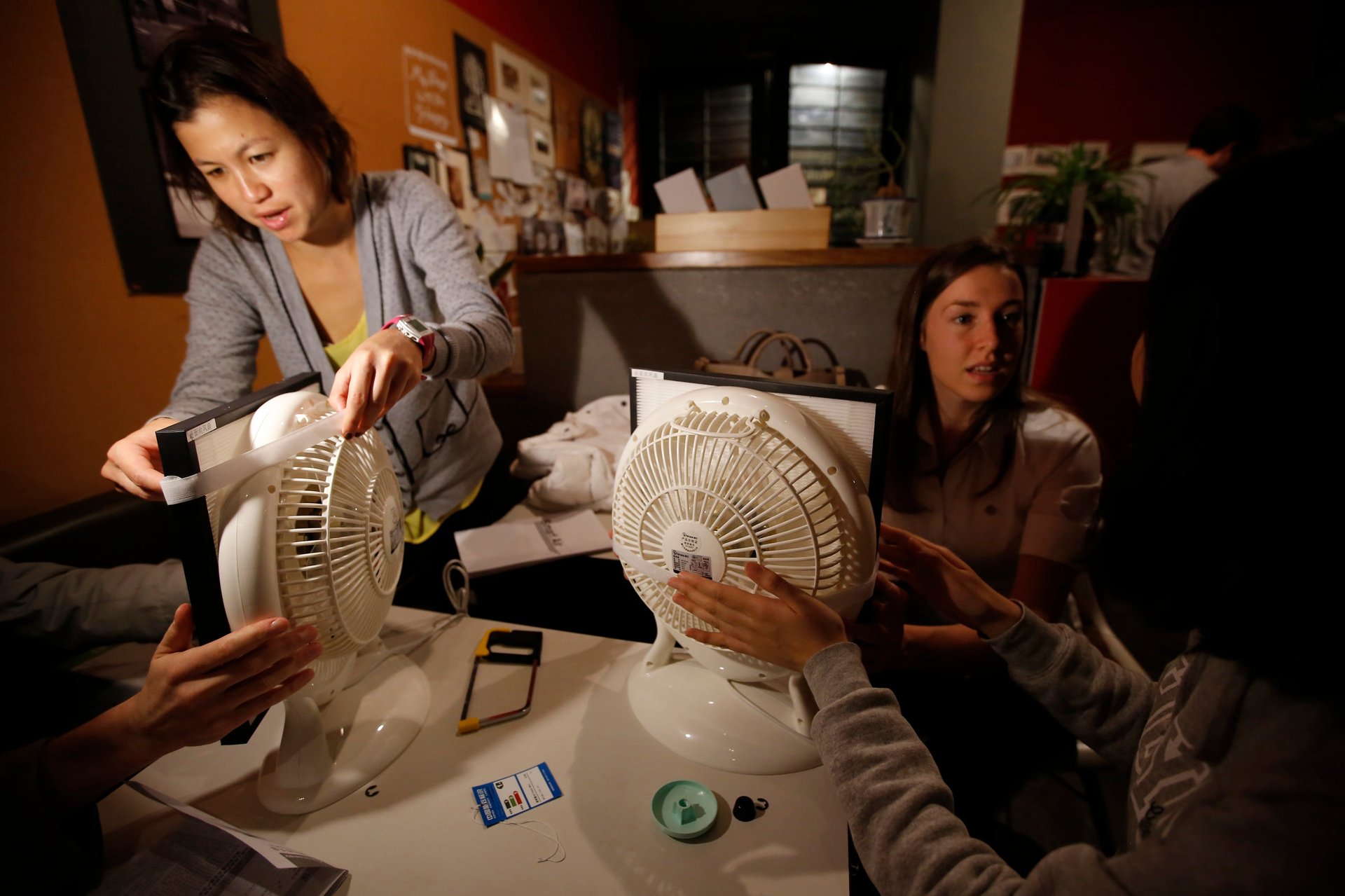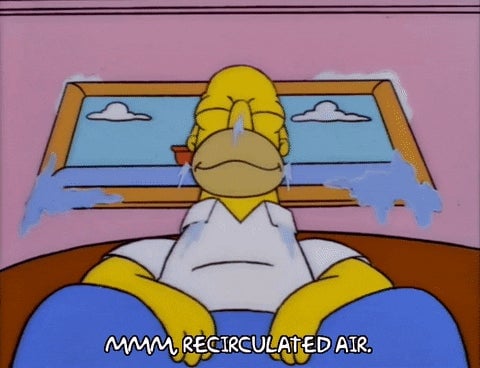Indoor air: the next public health frontier?
The ins and outs of indoor air

The ins and outs of indoor air
Suggested Reading
Most of us spend most of our time inside, breathing indoor air. But how much do we really know about the quality of that air? How certain can we be that breathing air in a crowded restaurant or sweaty gym won’t make us sick?
Related Content
Three years into the covid pandemic, we know that most covid transmission happens indoors, particularly in poorly ventilated spaces. Improving indoor air will reduce the spread of covid—and lower the incidences of a range of other health issues including respiratory diseases and cognitive deficits—with major implications for global public health.
The hope is that we can take lessons learned from covid to improve indoor air quality, much the way the 19th century cholera pandemic revolutionized water and sewage treatment systems. That means improving ventilation, filtration, air cleaning, and real-time monitoring of indoor air quality.
It sounds simple. It’s also a herculean task. The good news is that momentum is building. Take a deep breath, and let’s dive into what an indoor air revolution might look like.
By the digits
5: Air changes per hour that the US Centers for Disease Control recommends to maintain good ventilation
13: Air changes per hour typical of a wide body aircraft cabin, reaching 15 air changes per hour for narrow body planes; the high occupancy density of passenger aircraft means flying is still a relatively high-risk activity in terms of acquiring a viral infection, like covid or the flu
300-400 parts per million (ppm): Carbon dioxide typically found in outdoor air, though it can reach 600-900 ppm in urban areas
800 ppm: Carbon dioxide threshold that indicates the need for more indoor ventilation, according to the CDC
1%: Share of air that you inhale that is re-breathed, when at 800 ppm CO2 concentration indoors and 440 ppm CO2 concentration outdoors
3.2 million: Premature deaths worldwide attributable to household air pollution in 2020
Clearing the air
The technologies to power an indoor air revolution
In May, the American Society of Heating, Refrigerating and Air-Conditioning Engineers (ASHRAE) released a first-ever draft industry standard for mitigating infectious aerosols in buildings, proposing minimum ventilation, filtration, and air cleaning requirements for different settings.
One tool to help with implementation is carbon dioxide meters, since CO2 levels can serve as a proxy for how frequently fresh air is pumped into a space to replace exhaled air.
Belgium has mandated that all publicly accessible indoor spaces to display real-time air quality with devices such as a CO2 monitor. And the Netherlands has mandated CO2 monitoring in schools, setting aside €17 million ($18.6 million) to supply every classroom with a CO2 meter.
One problem with CO2 monitoring: it doesn’t tell us how air is filtered. Aerosol tracing is a technology that could address that shortfall.
One California-based startup, Poppy, has developed test kits consisting of sensors and diffusers to measure how air moves within an indoor setting, and how quickly particles are cleared. Based on that information, an office or school can make improvements by tweaking their HVAC system or opening windows.
Then there’s germicidal ultraviolet light (GUV), which uses UV energy to kill viruses, bacteria, and fungi. GUV advocates have called for subsidies and tax incentives to encourage building operators to install this well-tested technology. Way back in 1941, GUV was shown to reduce measles cases at schools. Harvard Medical School’s Edward Nardell calls GUV “the most effective, evidence-based, cost-effective, safe and available engineering intervention to disinfect air.”
Quotable
“The solution to everything is making the indoors more like the outdoors.”
—Joey Fox, a heating, ventilation, and air conditioning systems (HVAC) engineer based in Canada, speaking to Quartz
Pop quiz

What is the Wells-Riley model used for?
A. To calculate the infection risk of an airborne disease in an indoor space
B. To quantitatively assess the ventilation rate of a building
C. To calculate the generate rate of infectious respiratory aerosols
The air quality at the bottom of this email is excellent—and you’ll find the answer to the quiz there as well.
Brief history
A long time ago: When humans first brought fire into their homes, they discovered the need for a roof opening to let out smoke and maintain air supply to keep the fire going.
1824: English engineer Thomas Tredgold publishes The Principles of Warming and Ventilating Public Buildings, seminal work on building science and thermodynamics.
1836: Scottish physician David Boswell Reid conducts one of the first small-scale modeling studies of ventilation and heating of the British parliament’s debate chambers, eventually completing a ventilation system for the House of Commons in 1852.
Late 1800s: American physician John Shaw Billings argues for higher ventilation rates to mitigate the spread of diseases, especially tuberculosis.
1920s: The practice of insulating buildings is commercialized, improving efficiency in managing temperature and airflow in built structures.
1970s: Following the decade’s energy crisis, scientists invent the blower-door system for measuring building air leakage to improve their energy efficiency.
2003: The SARS pandemic—caused by the SARS-CoV-1 virus, the predecessor of covid-19 brings renewed attention to the role of airborne transmission and the need for clean indoor air.
Dec. 2021: The World Health Organization uses the term “airborne” in relation to covid for the first time.
2023: The American Society of Heating, Refrigerating and Air-Conditioning Engineers (ASHRAE) publishes a draft of the first-ever industry standard for mitigating infectious aerosols.
Fun fact!
The word ventilate comes from Latin ventilare, meaning “to expose to the wind.” Since the purpose of buildings is to create an environment more suitable than the outdoor climate, ventilation is meant to reproduce the effects of being “exposed to the wind”—that is, diluting and removing pollutants.
Take me down this 🐰 hole!
Architecture and air quality
The way buildings are constructed can affect how air moves up, down, and along them—and in turn, how infectious diseases travel among building inhabitants. A study published in August 2022 analyzed covid clusters in residential blocks in Hong Kong, detailing how indoor and outdoor drainage pipes determined patterns of vertical transmission.
Poll

How often do you think about the indoor air that you’re breathing?
- Never
- Every so often
- Multiple times a day
💬 Let’s talk!
In last week’s poll about retirement planning, a whopping 76% of you said that you’re laddering Treasury bonds and maxing out your 401k. Your accountants must be beaming!
Today’s email was written by Mary Hui (assesses restaurants in part based on their ventilation levels) and edited and produced by Annaliese Griffin (torn between her love of gas stoves and her appreciation for indoor air quality).
The correct answer is A. The classic model calculates the possibility of infection by taking into account the number of infectious cases, number of susceptible hosts, generation rate of infectious respiratory aerosols, exposure time, and the building ventilation rate, among other factors.